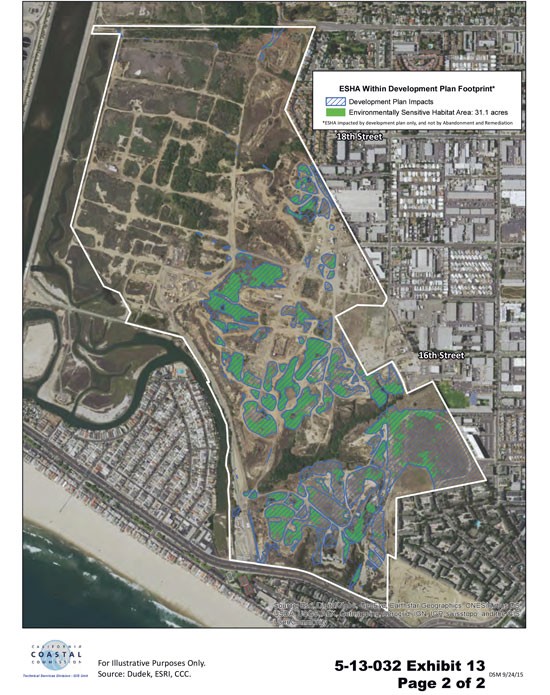
At the southwest end of Newport Beach lies Banning Ranch, 401 acres of slowly draining oil land dotted with rusted-out and broken down machinery, enough for it to resemble a wasteland, although the property farther from public view is beautiful–a network of streams, small canyons, vernal pools and wetlands bordering the mouth of Santa Ana River.
Despite the oil development, the area remains home to a variety of species once plentiful in Southern California–rare birds and owls that build burrows in the grasslands, endangered shrimp who live in the area's pools–as well as ecological formations found nowhere else in Southern California (a combination of lowlands, highlands, mesas and arroyos). It should be a public park, and for more than a decade, there have been two opposing proposals to turn it into one. On Wednesday, they'll be argued against each other in front of the California Coastal Commission.
]
The property's owners, a group of developers and investors calling themselves Newport Banning Ranch LLC, have proposed a chemical cleanup and urban development consisting of 1,375 houses, a 75-room hotel, a shopping center, parks and hundreds of acres of open space. “We're cleaning up a 75-year-old oil field,” says Chris Yelich, principal at Brooks Street, a real-estate-development firm that's part of the project. “In order to pay for that, we've got a development project we're proposing, of which 80 percent will be open space set up for native habitat.”
Opposing Newport Banning Ranch LLC are environmental groups and conservationists spearheaded by the Banning Ranch Conservancy. The outfit wants to keep the ranch in its natural state, cleaning up only what is necessary while preserving the wildlife that already exists on the site, adding trails throughout the property.
Last month, the developers hit a hiccup: Though their zoning was approved by Newport Beach voters as part of the omnibus general plan amendment Measure V in 2006, as well as by the Newport Beach City Council in 2012, Coastal Commission staff released a report recommending the commission deny the project based on the rarity and value of the site and on the relative destructiveness of Newport Banning Ranch LLC's development plan. Though the original plan includes 276 acres of open space (roughly 68 percent of the entire development), much of it would have to be disturbed to clean up pollution from decades of oil pumping to get to safe levels for commercial and residential development, and areas of the Ranch identified as environmentally sensitive would be developed for housing.
“There are very few sites along the Southern California coastline with the kind of diverse topography and habitat for wildlife found at this site,” reads the Coastal Commission staff report. “The presence of vernal pools at Banning Ranch adds a layer of diversity not even present at Bolsa Chica. In fact, it appears the subject site is the only area like it anywhere within the Santa Ana River watershed between the sea and the Santa Ana Mountains located 20 miles inland.” The report adds that instead of leveling the entire property for real-estate development, future oil-cleanup operations can be limited to the parts of the property that actually need cleaning up.
[
In response, the developers are introducing a revised plan, dropping the number of houses from 1,375 to 1,175 and raising the amount of open space from 68 percent to 80 percent of the site. The project would still call for the same intensity of cleanup, however. “With the project that we're proposing, the fence will come down, and there will be access to the beach,” says Yelich. “What's misleading about the plans put forth by the groups opposing us is showing the entire property as a park. With the approval of our plan, we can force oil operations onto 17 acres. Otherwise, they'll continue to operate for 75, 100 years, even longer depending on how technology develops.”
As an alternative to the Newport Banning Ranch LLC's plan, a local group of conservationists dating back more than a decade want to turn the entirety of Banning Ranch into a nature reserve, much in the same style as Frank and Frances Robinson leading the charge to save the Newport Back Bay from development in the 1960s and '70s. They say that the owner's Banning Ranch Development plan is irresponsible greenwashing–stressing open space though much of the existing habitats will be disturbed during cleanup–and dishonest in its claims that it's supported by Newport Beach voters.
While the city's residents passed the zoning law that makes it legal to develop Banning Ranch, that change was packaged with other revisions to the city's general plan. After the Newport Beach City Council approved the project in 2012, the Conservancy sued the city, claiming the project violated Newport Beach's general plan and the California Environmental Quality Act. It won in Orange County Superior Court, but lost in appeals. The California Supreme Court agreed to hear their appeal later this year.
“[We want] to raise money and buy the land after the project gets rejected by the Coastal Commission,” says Newport-raised Robert Moddelmog, one of the Banning Ranch Conservancy's volunteers and a current law student at UC Irvine. “The EPA gives out funds to clean up toxic-waste sites. We want to do a park, like the Back Bay–not as in soccer fields, but a nature reserve, hiking and jogging trails. The idea that if we don't clean this up now, it's going to be an oil field in perpetuity is totally bogus.”
To bolster their cause, the Conservancy plans to bus supporters to this week's Coastal Commission meeting, hoping that a large enough show of support can convince the commissioners to reject the project outright, in line with the recommendations of the staff. After a rejection, then the conservancy can concentrate on raising the estimated $150 million needed to buy the site. The group says it has already raised $5 million. “The main thing is, the community's against it,” says Moddelmog.

